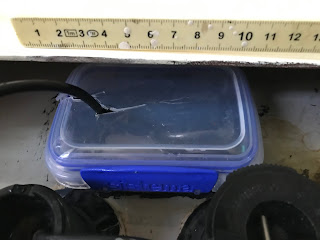To be fair, the depth gauge unit was Navman Multi 3100 with an LCD screen, about 15 years' old. It did everything else nicely, including a read out of the battery voltage, but as it had given up the ghost in its chief purpose of gauging depth, it had to go.
Being a cheapskate, I looked for the cheapest working alternative. I wanted an in-hull fitting, because I don't like the idea of putting holes into the hull (or bulkheads) and because I did not want to slip the boat again, at $350 a pop at least, to fit a new instrument. For me, the most important thing was a reliable reading of depth in water shallower than about 2m so that I would not run aground, and so that I would know how much anchor chain to let out when needed.
Having succeeded in fitting a Lowrance Hook 2 5x to the inside of the hull of my Austral 20, I decided to downgrade to a Lowrance Hook 2 4x with GPS for my Cavalier 28, which had a similar solid GRP hull, although much thicker. The unit cost about $160. With my Austral 20, I simply glued the bullet to a puddle of epoxy resin in the bilge, and it worked nicely to give depth readings.
One feature I like is that you can mount the head unit on a bracket screwed onto a bulkhead, so that it can be easily removed and stowed inside when the boat is unattended. This also saves having to cut a large new hole into the bulkhead, which not only weakens the structure but also presents another opportunity for water to get into the boat.
Initially, the 4x would not give a reliable reading of depth. To be fair on the Lowrance Hook 2 range, the transducers or bullets are designed to be mounted in the water on a bracket on the back of the transom as fish-finders. I was mounting mine inside the hull, and I was not interested in fish as much as the depth to the bottom, especially in shallow water.
I had glued my bullet with FixTech 180 to the bilge a little forward of the previous and now-redundant through-hull fittings. The 4x gave some readings, but proved to be unreliable. The shallow-water alarm went off in the middle of the channel near Peel Island, which is maybe 8m to 10m deep. Thinking I might have mounted the bullet over some obstruction in the hull construction, I prised it off, damaging it in the process, and tried blue-tacking it into several alternative locations. With the blue-tack, the depth readings disappeared entirely and I thought I might have bought a dud.
I phoned the shop I bought it from, Boating and RV in Tingalpa. Richard suggested I make a wet well inside the boat into which I should place the bullet. He suggested PVC pipe with a screw-on end, but I opted for cutting the bottom off an old Sistema clip-top food container and fixing it to the hull with FixTech 180. The clip-on top was needed to keep some water in the wet well when the boat heeled, and there was precious little room in the bilge for a larger screw-top arrangement.
I am happy to report that the wet well approach works well, and I got a nice, steady reading of a depth of 2.2m at my berth, which is what I expected (allowing for the bullet being about 0.3m to 0.5m below the waterline - I'll have to measure it more accurately). It also showed some fish, which were in no danger of being hunted by me at the time.
So, to recap, you can use a Hook2 4x Fishfinder as an in-hull depth gauge subject to two important conditions;
- The hull you are shooting through is solid GRP construction, not a core-filled sandwich
- The bullet is placed inside a wet well inside the hull, which you will have to make, including a lid to keep the water in. A food container or sandwich box with a sealable lid will do nicely
The end result is ugly and agricultural. The plastic food container was more difficult to cut than I had anticipated. However, as we engineers say, "If it is stupid and it works, its not stupid".
 |
| Sistema food container with bottom cut off, glued to hull with FixTech 180 |
 |
| Wet well filled with water, bullet inserted and lid on (the lid needs to be sealed properly) |
 |
| Depth gauge reading on head. Not easy to read in direct sunlight, but the head can be tilted down on its bracket. |


















